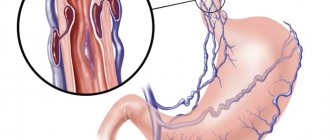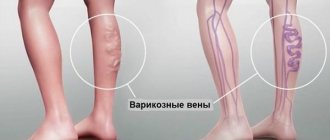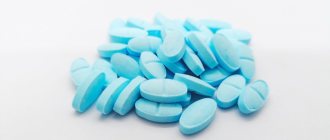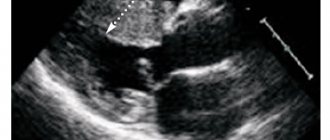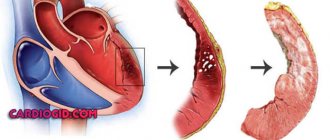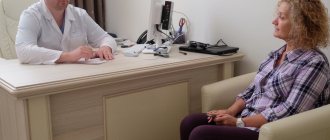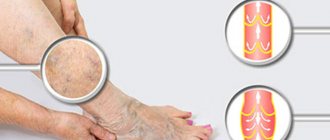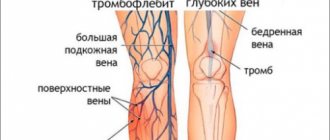Such a serious and painful disease as varicose veins on the inside and outside of the knee occurs in 10 percent of the population.
The occurrence of varicose veins in this area of the lower extremities may be due to its low location relative to the body, and therefore there is an increased load on this area.
If the patient constantly feels pain under the knee from behind, radiating to the joints, a feeling of fullness, burning, itching, then most likely there is varicose veins of the knee.
This type of varicose veins can develop due to the expansion of large veins in this area, accompanied by blood stagnation and increased pressure on the vessels.
As a result, there is a deficiency of oxygen and nutrients in the adjacent soft tissues, and an accumulation of decay products. The skin acquires an unhealthy dark color, loses natural moisture, and becomes vulnerable to touch.
If regular pain in the popliteal region is accompanied by the presence of dilated nodular veins in this area of the body, this is a sign of varicose veins under the knee.
Varicose veins of the lower extremities - what is it?
Varicose veins of the lower extremities - what is it? Why does it appear suddenly and progress so quickly? Today, it is considered a common disease in which there is an abnormal enlargement of veins that are visible through the skin and resemble blue or purple nodes. Varicose veins are a pathology that can occur in any part of the body, but is more common on the legs.
This is how varicose veins appear on the legs
Below are the most common signs of the disease. However, each person may only notice some of them.
Knee pain as a sign of varicose veins
Varicose veins are a fairly common disease of the legs, which is pathological in nature and manifests itself in the form of dilated veins. The symptoms of this disease are quite extensive:
- the patient experiences pain in the legs;
- vascular functions are impaired;
- swelling appears in the legs;
- heaviness appears in the place where the disease develops.
Most often, it is women who suffer from varicose veins, since their veins are designed in a special way, and pregnancy is often the cause of the disease. If you have any suspicious pain in the legs, you should immediately pay attention to where exactly it originated. If you feel pain behind the knee, then in this case thrombosis is possible, i.e. A blood clot has formed in a vein. The reason for this may be poor blood flow, for example due to a sedentary lifestyle.
As a result, too much blood accumulates in the vein itself, because of this the walls of the blood vessel begin to stretch, hence all kinds of pain with varicose veins. Most often, a pulling sensation occurs, and swelling is possible.
If you do not pay attention to varicose veins under the knee, and the pain is eliminated only with painkillers, this will lead to the popliteal vein becoming clogged, and the disease will develop into thrombosis.
Pain with varicose veins has the following character:
- the veins hurt very much, all this is accompanied by pulsation and burning;
- the patient feels a dull pain bursting from the inside;
- itching sensations occur in the lower leg area, swelling is possible;
- bothered by night cramps in the leg, accompanied by instant nagging pain;
- there is pain in the knee during movement;
- pain can cover the lower limbs completely, bringing with it a feeling of aching;
- The vessels themselves are also disturbing.
The pain may wax and wane. In this case, you cannot postpone visiting the doctor. If varicose veins are a fairly common disease, then thrombosis is less known to patients, although its occurrence is not excluded. Thrombosis makes itself felt when the patient experiences severe swelling in the knee joint, pain below the knee, and difficulty moving. In this case, there is no point in self-medicating. Thrombosis is a much more serious disease that leads to serious consequences, sometimes such an illness can cost one’s life.
Causes of varicose veins and risk factors?
Blood vessels in the body provide a channel for blood flow. In terms of the blood vessels of the lower extremities, the arteries carry high-pressure, oxygenated blood from the heart to the lower extremities. Veins therefore have thinner and less elastic walls than arteries. If pressure rises in the veins for any reason over a long period of time, this can become the main cause of varicose veins of the lower extremities. The disease is also facilitated by malfunction or damage to the valves that help push blood upward.
The functioning of venous valves normally and with varicose veins
About 30% of adults worldwide suffer from the disease. The risk varies greatly by age and gender. The following are risk factors:
- Obesity. Obesity is a major risk factor for the development of varicose veins of the lower extremities. Excessive weight increases pressure in the veins and aggravates their condition.
- Heredity. Heredity plays an important role in determining susceptibility to varicose veins, but specific factors responsible have not been identified.
- Inaction. Prolonged inactivity or, conversely, increased activity increases pressure in the veins.
- Floor. Women are especially susceptible to varicose veins of the lower extremities due to the effect of progesterone on the veins, as well as the effects of pregnancy. Women have a 3 times higher risk of developing the disease.
- Pregnancy. Varicose veins of the lower extremities during pregnancy occur due to hormonal influences. However, enlarged veins often return to normal within one year after giving birth. Pelvic varicose veins may also be observed.
- Age. Varicose veins of the lower extremities usually affect people between 30 and 70 years of age. As we age, the elastic lining of the vein begins to weaken, increasing the chances of enlarged veins.
A risk factor is anything that can increase a person's chances of developing a disease. This could be due to activities such as smoking, diet and many other reasons.
Symptoms of the disease
How do varicose veins under the knee manifest themselves? If you have any symptoms, you should immediately make an appointment with a phlebologist?
- A capillary network that occurs in the calf area, the appearance of which is caused by inflammatory processes in small vessels.
- The appearance of tortuous, nodular large veins protruding just under the surface of the skin.
- Pain under the knee with varicose veins, which bothers the patient in the initial stages of the disease only during the active period of the day. With its further development, the pain syndrome can occur around the clock, even in a state of complete rest.
- Serious swelling of the legs, eliminated in the initial stages by prolonged periods of rest. If timely measures are not taken and the disease is allowed to develop, swelling can constantly bother the patient.
- Dehydration of the skin located directly above the veins under the knee, a change in their color towards darkening, either a burgundy or violet-brown tint, and a feeling of persistent itching can be observed. When scratching, there is a risk of pathogenic bacteria entering directly into the blood and affected vessels, which can lead to ulcers and even blood sepsis.
- The feeling that the veins located in the knees are pulsating strongly, the blood passes through them unevenly, in jerks.
- A constant burning sensation in the popliteal region may indicate a change in temperature in the affected part of the body.
- Convulsive manifestations that bother the patient mainly during night sleep or relaxing rest.
Varicose veins of the lower extremities - stages
- First. Spider veins appear;
- Second. Nodules are visible;
- Third. Swelling of the legs is added;
- Fourth. Skin color becomes darker, almost purple;
- Fifth and sixth. Ulcers form, which may not heal as a result.
This is what varicose veins look like in stage II of the disease
Varicose veins of the lower extremities - diagnosis
In addition to reviewing your medical history as well as a physical examination, testing for vein disease may include the following:
- Duplex scanning is a type of procedure that evaluates the blood flow and structure of the veins in the legs.
- Triplex ultrasound is a procedure similar to duplex ultrasound, which uses color to highlight the direction of blood flow.
- Magnetic resonance venography (MRV) is a diagnostic procedure that uses magnetic resonance technology and intravenous contrast material to visualize veins.
Diagnosis of varicose veins of the lower extremities is carried out with the patient standing
Diagnostics is necessary so that the doctor can prescribe a treatment method that is most suitable for the patient.
Thrombosis of the popliteal vein: symptoms
Standard symptoms of popliteal vein thrombosis appear only in half of the cases, so sometimes the disease is difficult to diagnose. The main symptoms of the pathology include acute, prolonged pain in the lower leg area, which can intensify in the evening and at night.
.
Statistics on the localization of thrombotic lesions
Also, popliteal thrombosis may be accompanied by the following changes:
- when playing sports and physical activity, the leg begins to hurt sharply;
- if you try to bend your foot towards you, you feel pain in your lower leg;
- the limb swells, turns blue, the skin begins to shine;
- there is a feeling of heaviness and distension in the limb.
The person may feel weak and have trouble moving.
Varicose veins of the lower extremities - complications
If varicose veins on the legs are not treated, serious problems may arise in the future, both with the veins and with the skin of the legs.
- Trophic ulcers.
- Phlebitis is inflammation of the veins.
- Deep vein thrombosis (DVT), where blood clots form in the deep veins of the legs. This complication can be fatal.
Because of this, the disease can cause significant discomfort and even disability depending on any underlying tasks and severity. Some of these complications can be very life-threatening.
Causes of the disease
To effectively fight varicose veins, you need to understand what caused it. There are many factors for the appearance of varicose veins, among which are:
- Varicose veins can be a hereditary disease, i.e. transmitted at the genetic level from older to younger generations;
- appears in office employees who constantly sit in one position, as well as people who reject an active lifestyle;
- varicose veins can be caused by work during which you have to stand for a long time;
- the disease often occurs in pregnant women;
- varicose veins are a common companion to obesity;
- varicose veins can appear in those who play sports too hard, putting stress on their legs;
- Hormonal imbalances in the body can lead to the disease.
The largest number of patients belong to the group that receives a predisposition to varicose veins at the genetic level, but it is known that genetics cannot be the only cause. The occurrence of varicose veins is always the result of several problems.
Varicose veins of the lower extremities - drug treatment
It is not always necessary, but if you are concerned about pain, ulcers or just discomfort, then, as a rule, you need to go to the hospital. But do not forget about complications, some of which lead to death, therefore, in order not to worsen the general condition, do not ignore treatment and seek medical help if you have varicose veins of the lower extremities. The doctor will explain conservative treatment and its essence.
One of the most popular venotonic drugs
Popliteal vein thrombosis: diagnosis
To determine the exact signs of thrombosis, duplex ultrasound scanning (USDS) is used. The method helps to find a blood clot, measure it, determine its exact location, and recognize whether it is floating in the vessel. The method also helps to examine the condition of the veins. In addition, during the examination, doctors receive information at what speed the blood moves.
Diagnosis of popliteal vein thrombosis
Doppler ultrasound is also used in diagnosis. This method is used to determine the patency of the veins and find the place where the thrombus is located.
Varicose veins of the lower extremities, treatment. Operation?
Don't panic if you are diagnosed with varicose veins of the lower extremities. Sclerotherapy treatment may help. This procedure is based on the use of a special solution that is injected into varicose veins. Varicose veins of the lower extremities disappear quite quickly. Sclerotherapy treatment is suitable for treating small veins such as spider veins. Are you afraid of a knife? Varicose veins of the lower extremities can be removed (treatment without surgery). You just need to find a decent doctor.
Varicose veins. Laser treatment in Moscow
Life does not end if you have varicose veins of the lower extremities. Laser treatment will help. The doctor inserts a tiny fiber into the varicose veins through a catheter. The fiber sends out energy that destroys the affected part.
This is a tiny laser fiber that completely eliminates varicose veins
Do varicose veins of the lower extremities remain? Laser treatment, which may seem expensive, is very effective, so the answer is no. Not every patient worries if he has varicose veins of the lower extremities. However, laser treatment leaves only positive reviews. With it, varicose veins of the lower extremities will be defeated! Laser treatment (you will find out the cost at the clinic from the administrator) is short-lived and inexpensive.
Varicose veins. Radio frequency treatment
What to do if you have severe varicose veins of the lower extremities? RFA treatment in Moscow is the safest method, which involves heating the venous wall using radiofrequency energy. Varicose veins of the lower extremities disappear permanently. RFA treatment is very convenient.
How quickly do varicose veins of the lower extremities disappear? RFO treatment in Moscow will convince you of its rapid effect. You will remove varicose veins of the lower extremities. RFO treatment is performed at the highest level. Look at the photos and results - make sure the procedure is effective.
Diagnosis and treatment
A phlebologist deals with the problem of diseased veins, and it is he who conducts the initial examination of the patient. An ultrasound examination of the lower extremities is also carried out, thanks to which the doctor examines not only the subcutaneous vessels, but also the deep ones, where thrombosis can occur.
All results and conclusions are made based on the examination and complaints of the patient.
If the patient's condition is deplorable and thrombosis is detected in his leg, the following treatment may be prescribed:
- bed rest;
- Elastic bandages and compresses with an alcohol solution are prescribed;
- ointments may be prescribed, for example Lyoton ointment and its analogues;
- anti-inflammatory gels, such as Diclofenac or Indovazin;
- pain due to varicose veins in the back of the knee is treated with Troxevasin or Rutozid ointments;
- the patient will need to take anti-inflammatory pills;
- in case of serious complications, anticoagulants are prescribed;
- You should definitely take thrombolytic medications;
- Antibiotics may be prescribed if the patient develops an infection.
Sometimes the patient may be placed on the operating table. Such treatment is carried out as follows: the patient is either injected with a special chemical substance, or the diseased veins are removed using special punctures. After such an operation, the patient is prescribed to wear a special compression bandage. This often happens when blood clots break off under the knee. In this case, treatment without surgery is impossible.
How to treat varicose veins of the lower extremities with ointments
Today, modern drugs can surprise you with their effectiveness and quick results, however, you should not do anything without the advice of a doctor.
- Anti-varicose leg cream – relaxes and relieves pain. Strengthens the walls of blood vessels.
- Heparin thins the blood and helps reduce the formation of blood clots.
- Lyoton 1000 - relieves swelling, strengthens the walls of blood vessels, but does not completely remove varicose veins of the lower extremities. Treatment (the cost of Lyoton is more than that of other creams) in this way is still incomplete.
Of course, the easiest way is to go to the pharmacy and start treatment yourself, however, you don’t need to flatter yourself with hopes that the ointment or gel will provide you with reliable treatment and will not cause complications. Consult a doctor and do not deceive yourself.
Popliteal vein thrombosis: treatment
If we talk about the dangers of popliteal vein thrombosis, then first of all it is worth mentioning its complications. More than 10% of patients die from them. If the disease is not treated, blood clots can break off and travel through the vessels. When they enter the lungs, they completely block the lumen of the pulmonary artery. This leads to death in most cases.
It is the danger of complications that is taken into account when choosing a treatment method. Most patients are recommended to be treated in a hospital. If their risk of thromboembolism is high, treatment will take longer. In the first days of treatment (from 3 to 10 days), the patient must remain in bed. In this case, the affected limb should be elevated at all times. This is especially important if doctors are unable to conduct a complete examination.
The ratio of venous and arterial thrombosis
If conservative treatment of thrombosis does not have an effect, doctors recommend that the patient undergo surgery.
Many patients are given medication to treat thrombosis in combination with the use of elastic compression bandages, which help protect the valves and increase blood flow. To increase the effectiveness of treatment, local topical preparations are used. Such products (creams, ointments, venotonic tonics) are recommended to be used regularly after exacerbations, as a preventive measure.
Treatment is also accompanied by internal medication. The patient is prescribed anticoagulants to slow blood clotting and protect against blood clots. For severe pain, analgesics are also prescribed. To increase blood flow from the legs, phlebotonics are used.
Expert opinion
Angioprotectors are widely used in the treatment of this disease. These are special preparations with complex action. They suppress the inflammatory process, restore vascular walls, improve blood composition and accelerate microcirculation. Also, such products help fight swelling. .
Vascular surgeon, phlebologist
Osipova Ekaterina Yakovlevna
In some cases, antibiotics are also used in treatment. The doctor develops suitable therapy in each case individually.
To reduce the manifestations of popliteal vein thrombosis, the use of Normaven® products is recommended as an additional measure. Testing of the Foot Cream proves that its use for 3 months can reduce the feeling of heaviness and fatigue in the lower extremities, minimize cramps and swelling, and also reduce the severity of the vascular pattern. The product was developed by specialists from the pharmaceutical company VERTEX and has the necessary documents and certificates.
Treatment of thrombosis with folk remedies
Varicose veins of the lower extremities - treatment at home
How unpleasant varicose veins of the lower extremities are! Our grandmothers still use folk remedies to this day, and knowing the effect of medicinal herbs, you can relieve symptoms and strengthen the walls of blood vessels. But make no mistake - serious varicose veins of the lower extremities, treatment, price, results - everything is interconnected.
- Horse chestnut. Dried flowers (50 g) are poured with vodka (500 ml). Let it brew for 20-21 days and take it orally, before meals, 25-30 drops 2 times a day.
- Garlic ointment. Make a paste of garlic and butter. Rub in before going to bed.
- Apple vinegar. 2 tsp dilute in 200 ml of water. Take before meals. This product has good reviews.
It is important to know that varicose veins of the lower extremities (prices, photos, results are available online) cannot be completely removed with herbs.
How to cure varicose veins permanently?
Unfortunately, if you neglect the disease, both you and your doctor will have to work hard to forget about varicose veins in your legs. At the first stage, the disease responds well to any treatment method, but later stages can upset you. You shouldn’t think about how to treat varicose veins of the lower extremities at home. Contact our center and you will be prescribed the right treatment, thanks to which you can get the desired result.
All you need to do is take better care of your health and adhere to basic preventative measures.
Diagnostic measures
So, the patient is at the doctor's appointment. What methods of identifying an insidious disease will the doctor use? These measures will most likely include the following:
- Why does it hurt behind the knee when bending and straightening - what to do and how to treat this pain
- Referral for a general blood test, as well as a special study of its coagulation.
- Contrast radiography, when a special composition is introduced into the vessels, allowing a thorough study of the condition of the veins as a result of radiographic examination.
- Duplex color ultrasound scanning of venous vessels, which can determine the condition of not only subcutaneous vessels, but also veins located deep in the thickness of the muscles.
Based on the results of diagnostic studies, the doctor determines how to treat varicose veins. Treatment measures have three main goals:
- Relief of the inflammatory process.
- Elimination of pain.
- Prevention of recurrence of the disease and prevention of complications.
Frequently asked questions from our patients on the Internet
How to deal with varicose veins on the legs? Daria from Saratov is interested in:
Dear Daria! It is necessary to combat varicose veins in the legs with the help of good specialists. No matter how promising and colorful the sites with guides and advice on self-medication are, remember, they are written by people far from medicine.
How to check your legs for varicose veins? Svetlana from Kazan asks:
Dear Svetlana! As a rule, it is possible to qualitatively check your legs for the presence of varicose veins only in a clinic or medical center specializing in the treatment of veins.
How to diagnose varicose veins? Interested in Lyubov from Stavropol:
Dear Love! You can diagnose your legs for varicose veins at a consultation with any of our phlebologists with an ultrasound duplex scan of the venous system. How easy is it to do this with us? Make an appointment for a consultation at any time convenient for you by phone.
